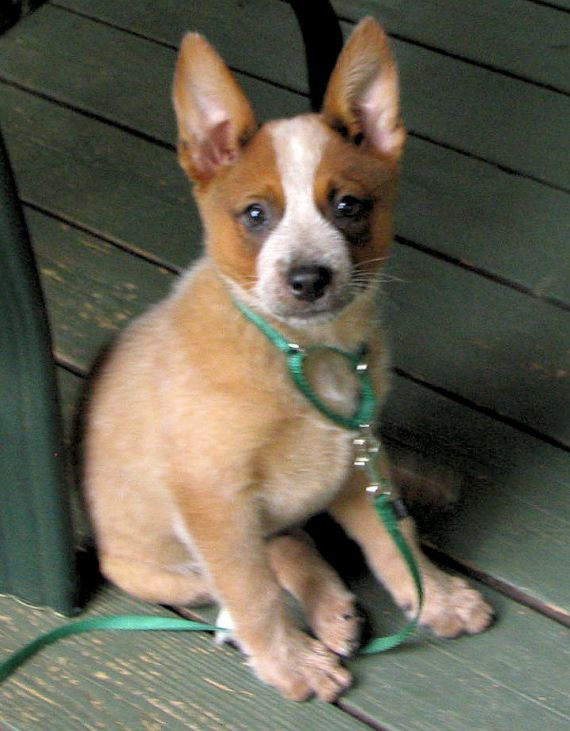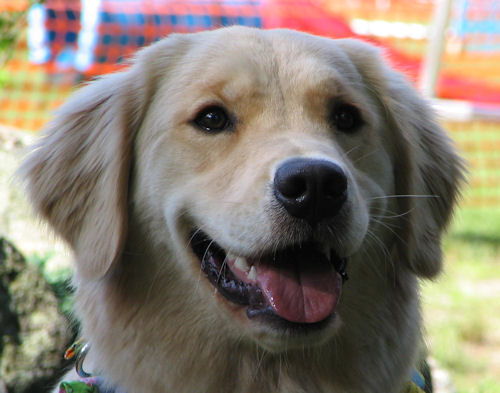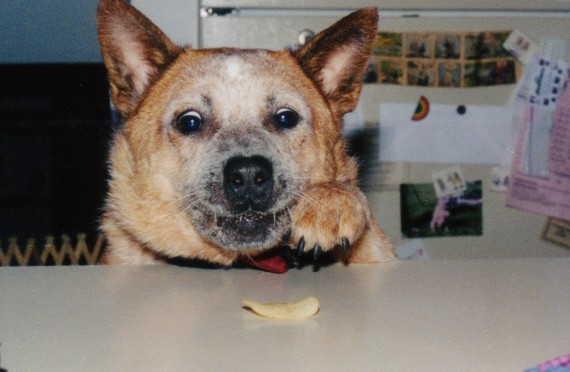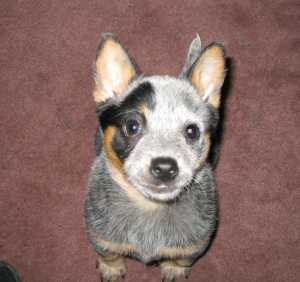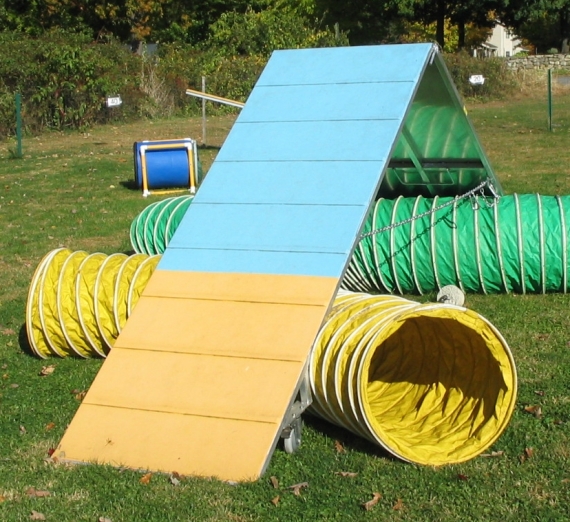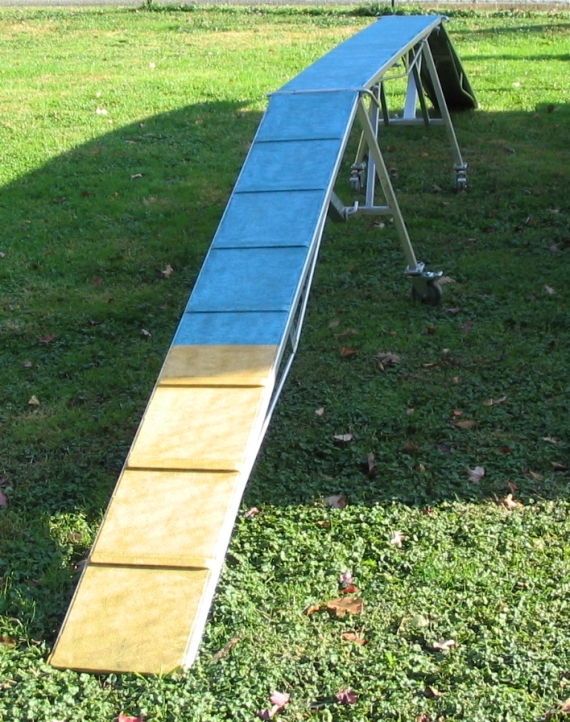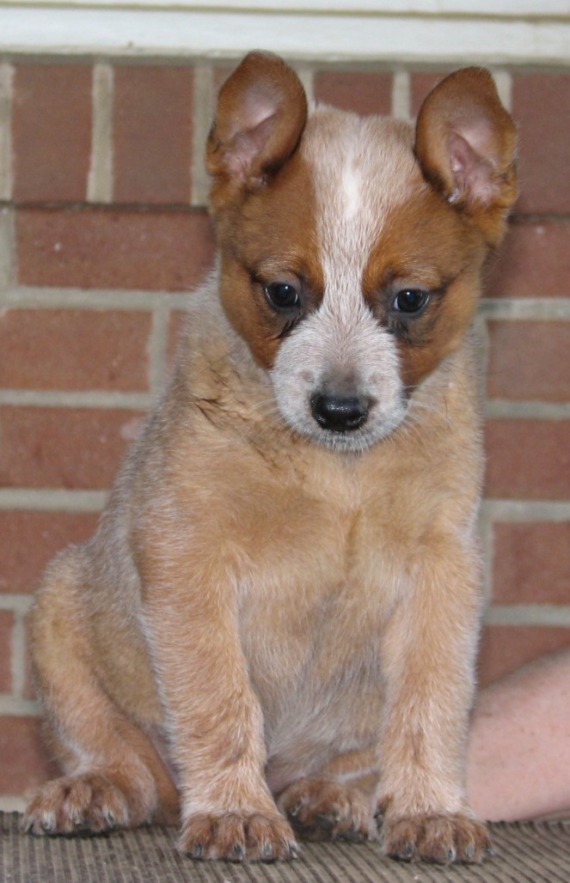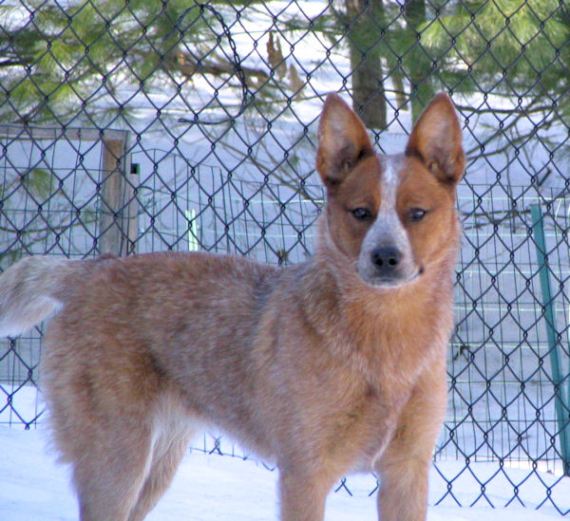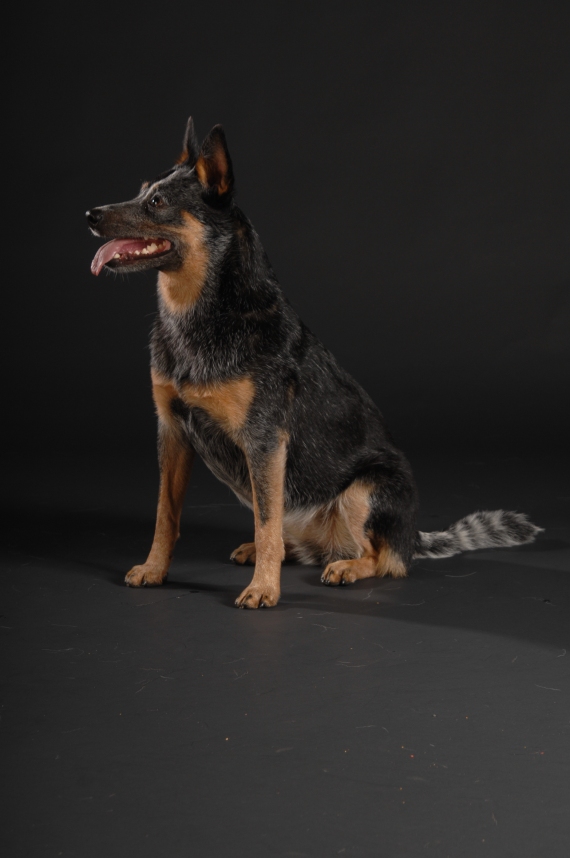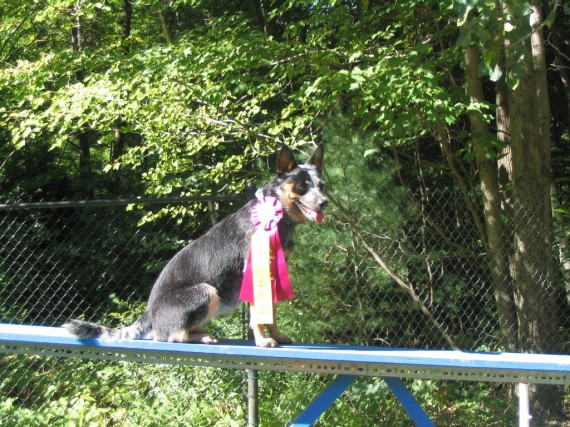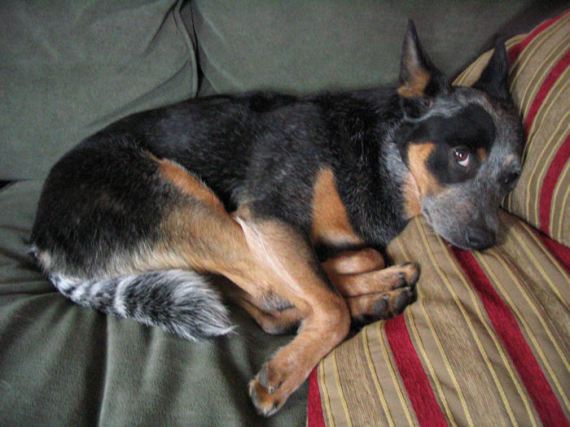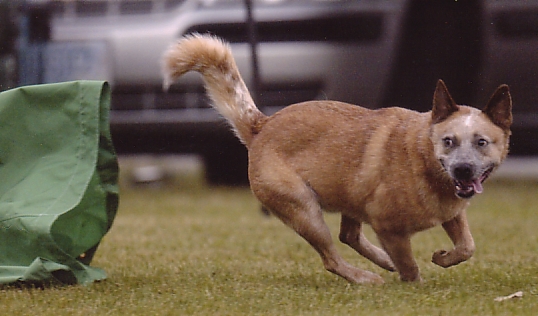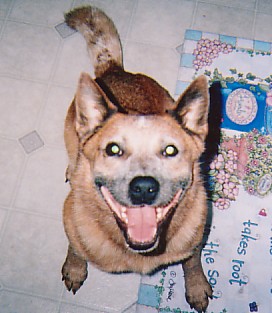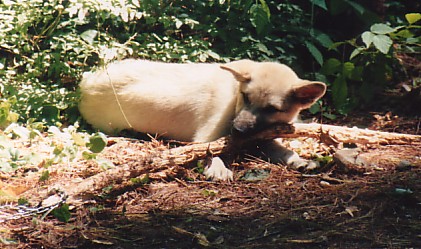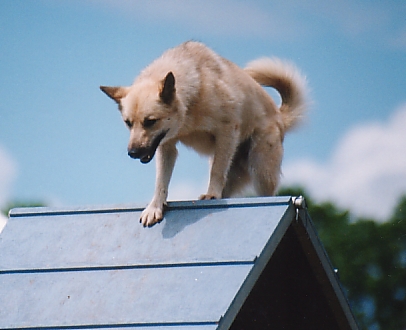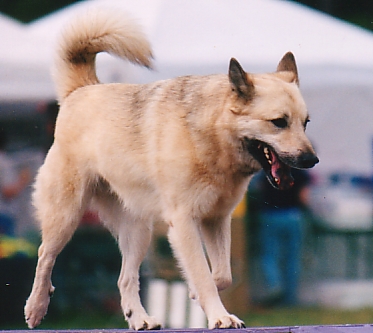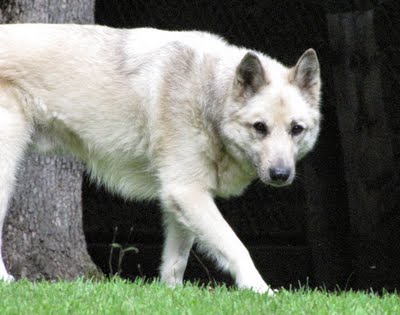Since I have been so busy getting ready for winter, I haven’t written any new posts. So here are a bunch of pictures to share, offered up without explanation. Just enjoy, okay?
10 Nov
Pictures to share
20 Oct
Ribbons
In agility, when you qualify or place in the top 4 of your group, you earn ribbons. They are silly little things, but we’re damn proud of them. We could do one of those stupid Visa commercials:
- Entries fees for Dog Show: $200
- 2 Nights hotel, food: $250
- Gas, Tolls, Parking: $50
- 39 cent 1st place Ribbon: Priceless.
I have been competeing with Beta for about 3 years now. Below is my collection of ribbons. I now only take a placement ribbon – 1st, 2nd, 3th, or 4th if I also qualify, as I don’t have room:
Note the large amount of Blue (1st place) and Red (2nd place) ribbons. Usually, with Beta, either we do well and take 1st or 2nd, or we crash and burn and get eliminated.
Here is my meager collection with my old dog, Tyler:
Note that there are a lot of Yellow (3th place) and White (4th place) ribbons. Tyler was never fast, but he was steady.
20 Oct
Beta earns her Master Jumper Title
Over Columbus Day weekend, we went to an agility trial up in N.H. Beta did very well, and Qualified and took 2nd place in Jumpers (which is really the drag racing of agility – nothing but jumps – the dogs run pretty much flat out). Since this was our 5th qualifying run in this event at the Masters level, it earns us the Masters Jumper Title. Here’s the video:
The course was 147 yards, and she ran it in 30.76 seconds.
20 Oct
What is Agility? Part 1
Agility is, in essence, a timed obstacle course for dogs. The handler (the person) directs the dog through a series of obstacles using voice commands, hand signals, and other cues such as body language, position, and acceleration/deceleration. You may not use a leash, toys, treats, or any other training device when “in the ring” – you run “naked”. There are several variations on the basic game, and slightly different rules between the various organizations that sanction the events. In the following paragraphs, I’ll give you a glimpse into the wacky world of Agility.
The Dogs
What dogs can do agility? Which ones are good at it? Any breed, or mix of breeds, can be trained to do agility. Active, energetic dogs are much better at it. And intelligent, strong, focused dogs are really good at it. The most numerous breed of dog at agility shows is usually the Border Collie – it is ideally suited to this sport. If you are familiar with the AKC groups, you’ll find that the Working, Herding, and Sporting groups are well represented at agility shows. Labs and Retrievers are popular, in the big dog groups. In the mid to smaller sized dogs, you find Shelties, Cockers and Springers. In the small dog groups, you find mini Poodles, Pomeranians, and Jack Russells. But I have seen almost every common breed at shows – Great Danes and Wolfhounds, Bassetts and Beagles, Dobermans and Miniature Pinschers, Whippets and Greyhounds. It is not about the breed – it is all about the dog. I have an Australian Cattle Dog – they are very well suited to the sport, much like the Border Collie. They have intelligence, strength, and drive – excellent traits for agility, but they are also stubborn, dominant, and can be aggressive – very bad traits when around a lot of other dogs. Finally, mixed breeds are very well represented at the organizations that allow them to compete. The intentional mixed breeds (designer breeds, they’re called), such as the Labradoodle, are seen, as well as a whole lot of shelter rescue dogs. And there are some folks that are creating new “designer” breeds just to try and get good agility dogs – mixing Border Collies with smaller breeds to get strong, small, fast dogs. It is, after all, all about the dog(s).
The Obstacles
Agility obstacles fall into to 4 categories: jumps, tunnels, ramps, and everything else (poles and table). I’ll describe them all, with some pictures, so you can get the feel for what they are.
Jumps
You would think that “jumps” are pretty obvious, but there are several kinds: standard jumps, wing jumps, spread jumps, and long jumps. Standard jumps are the obvious jump – two upright poles with one or more horizontal poles (bars) spread between them. The dog must jump over the bar, and between the upright posts to successfully complete the obstacle. Wing jumps are like standard jumps, but they have “wings” sticking out to the outside of the upright posts , which forces the handler to be a little further away when running by it. Spread jumps have depth as well as height – there is a second (and sometimes a third) bar on additional uprights behind the first one – the dog must clear all the bars in one jump. Long jumps (or broad jumps) are a set of panels (at a minimal height) laid on the ground – the dog must jump across them all without landing on them. There is also a special jump, called the tire – it is exactly what is sounds like. It is just like the old tire swing – a suspended circle which the dog must jump through. And finally, there is the panel jump, which is a variation of the standard/wing jump. The space between the upright poles is filled with panels, so the dog cannot see what is on the other side as it approaches. With only a few exceptions, jumps, in their many variations, make up the bulk of the obstacles in any given course.
Tunnels
There are two types of tunnels – a standard open tube tunnel (measuring 24 inches in diameter), and a “closed” tunnel, also called a chute. The standard tunnel is flexible – it can be bent into any shape, such as a “U” or an “S” curve, or can be left in a straight line (in what is known to most of us handlers as a particle accelerator – many dogs come out of a straight tunnel faster than they went in). Most dogs LOVE tunnels – some will, if you let your guard down, “choose” to go do a tunnel over any other obstacle; we have a name for these dogs – tunnel sucking dogs. The chute is a tunnel with a fixed barrel at the start, and then a fabric tube of between 8 to 15 feet attached to it. This fabric will “close” – i.e. lie flat on the ground. The dog cannot see all the way through it – in fact, they will actually have to push their way through to the end. This is normally a training challenge for young dogs. And sometimes, when there is a good breeze blowing in the right direction, a closed tunnel can be an open tunnel! The other thing about the chute/closed tunnel is that it is the only obstacle that requires someone reset it after each dog has performed it. The fabric can become twisted or tangled, and if not straightened, can cause the next dog to get trapped. (A breeze in the wrong direction can do that, too.) So there is always someone assigned to “straighten” the chute after each dog in a competition. While there might be several standard tunnels in a course, there is never more than one chute.
Ramps
There are 3 pieces of ramp obstacles, or contact equipment: the dog walk, the A-frame, and the see-saw. The dog walk is 12 inches wide, 36 feet long, and is comprised of a 12 foot ramp up, a 12 foot level plank (at a height of 4 feet), and a 12 foot ramp down. (Some dogs can do this obstacle in under 3 seconds – think about that – you couldn’t do that!) The A-Frame is just what is sounds like – it is two 3 foot wide by 9 foot long ramps hinged together at the top. The height of the peak varies by different rules, but is between 5 feet and 6 feet 3 inches off the ground, making this a rather steep obtacle. And the see-saw is also just what it sounds like – a 12 inch wide, 12 foot long plank which rests on a pivot near the middle. The dog must run up it, force it to tip down on the other side, and wait for it to touch the ground before leaving the plank – this is also a real training challenge. All three ramp obstacles have what are called contact zones on the start of the ascending ramp and the finish of the descending ramp (hence they are called contact obstacles). These zones must be colored to stand out from the rest of the obstacle, and the dog is suppose to make contact with them on the way up and down. The “up” contact is not required in all venues, but the “down” contact is – this is designed as a safety rule, and as a way to ensure that all dogs do the whole obstacle – not jumping off at the top or part way down. There is never more than one of each of these in a course, and depending on the particular game, they may not be there at all.
And for the record, here is an example of how a dog is not suppose to perform a contact obstacle (the video plays at a faster than normal rate, but you get the idea):
Weave Poles and Table
Ah, the weave poles. This is a slalom obstacle – a group of upright poles (usually 6 or 12) that the dog must weave through. The dog must always start performing the obstacle by having the first pole on their left, and then proceed to weave, or slalom, their way through them. This is an incredibly hard obstacle to train, and can be one of the toughest obstacle in the course.
The final obstacle is the Pause Table. It is a 3 foot by 3 foot table that the dog must jump up on and pause for 5 seconds. Depending on the particular rules of the competition, they may have to either sit or lay down. The height of the table is adjusted for the height of the dogs, from 8 inches to 24 inches. Training the dog to do this obstacle isn’t real tough, but it seems that getting correct execution in a competition can be a challenge. My dog Beta barks at me the whole time she is on the table – she does not want to stop – she wants to go, go go!
14 Oct
The Motley Crew
14 Oct
Kindle
Kindle is the baby. She is also an Australian Cattle Dog, and is 18 months old. She is also my wife’s dog, and the newest addition to the family. She is great! She has the intelligence of a Cattle Dog, but is sweet and loving – she actually likes to cuddle. How can you go wrong when you start like this:
And you currently look like this:
I’ll update this post more later, but here is a video of Kindle being introduced to Winee, our friend’s young Golden (who wasn’t much more than a puppy herself at the time):
14 Oct
Beta
Beta is the “agile dog” – her full name is Bryn Mawr’s All Rev’d Up. She is the one pictured on the right sidebar at the top of the blog, and the dog I compete in Agility with. While Jack, our first Australian Cattle Dog, is my wife’s dog, Beta is my dog. She is both the first Cattle Dog I have ever owned, and also the first pure-breed dog I have owned – this is known as jumping in with both feet. From the start, Beta was eye-catching:
My wife did the research to find Beta’s breeder; the breeder actually vetted us as potential owners – the sign of a really good breeder. I knew within moments of meeting the dog that I wanted to take her; I have been rewarded for that choice ever since. Beta has all of the main traits of an ACD: smart, energetic, loyal, stubborn, and dominant. She also loves people; she even likes strangers, which is NOT a normal ACD trait. She can be defensive of bigger dogs, but is quite good with dogs her size and smaller, even puppies (which is also not normal for an ACD). She is a “Blue” ACD, the more common color, and has the cool common markings of an ACD. But she has distinctive white rings in her tail, very much like a racoon or a ring-tailed lemur. She is also small for a Cattle Dog – under 16″ at the shoulders. Given her slightly smaller size, boundless energy, drive, and intelligence, she is a natural for Agility. With her natural talent, cool looks, and outgoing nature, she is a real hit on the Agility circuit here in New England. First, a glamour shot:
Now some Agility action photos:
Why “Beta”, you ask? First, I’m a software geek, and had already trained my first agility dog (Tyler). So this was my second attempt, hence “Beta” -like beta software. Also, it was a subtle reminder to myself to remain in charge – be the “alpha dog” so to speak. A Cattle Dog will try to be in charge if you let them, and nothing good will come of it. Third, it’s different, and doesn’t get confused with all the “normal” names at dog shows. And finally, there is a thought in dog training that a dog’s call name (their common name) should be two syllables, and end in a vowel, to make it easier to call them with a positive inflection.
One of the main points of this blog will be to post photos and videos of Beta (and me, when I’m with her). How can you resist this?:
8 Oct
Jackaroo
Jackaroo, officially Koala Redhot Jumpin Jackaroo, or Jack, was our first Australian Cattle Dog. He is technically my wife’s dog, and he is the first pure-bred dog we ever owned. Australian Cattle Dogs (ACD, also known as Queensland Heelers or Blue Heelers) are an exciting breed: smart, strong, active, and loyal. They are also not for the inexperienced – they have a strong bite instinct (it’s part of how they herd livestock), and can be very dominant and stubborn.
We got Jack from a breeder – he was the first dog we had to really pay for (besides the adoption fees from shelters). Here he is as a puppy:
Jack is an awesome dog. He is extremely smart, and likes to watch TV. He is something else to watch run agility – he clearly loves it. He is quite loud though – he barks almost constantly.
Here is Jack coming out of the chute:
You can see the intensity in his eyes – he is a maniac! I like to describe ACDs to people as a “cinderblock with a lit rocket straped to it” – that describes Jack perfectly most of the time. Here is a good shot from a photo session we did that shows how muscular he is:
And another thing about ACDs: they have a permant smile. It’s something about the way the mouth is shaped/colored. Here’s Jack’s:
7 Oct
Tyler
Tyler is a special dog, especially to me. He is my dog (versus being my wife’s), and he is the first dog I had that I did formal training with. That training really helps bond the owner with the pet, and it definitely did that here. First, a puppy pic:
We adopted Tyler from a shelter when he was about 3 or 4 months old. After just two days, he became VERY sick, and we thought we were going to lose him (a story for another day). But after nearly a week, he recovered, and is now 12 years old. I took him for all the normal obedience training, and then since my wife was having success with her dog Tasha at agility, I started training Tyler for it. Here are the obligitory action shots:
and:
Tyler was never great at Agility – he did it because he got a lot of treats for it. He just enjoyed greeting people, getting petted, and begging treats from people (he is VERY good at that).
In some ways, this is a dream dog. He is quiet. He is calm. He is friendly. He doesn’t want trouble with other dogs – if they are good with him, he is good with them. He passed the test for being a Therapy dog, but I don’t have the time to take him visiting seniors or the hospitalized. He doesn’t play with toys, or chase frisbees, or even fetch sticks, but he does like walks in the woods and chasing small (and even large) furry animals. All and all, he is a great dog.
Tyler is offically listed with the AKC as a Norwegian Buhund (go look it up!). He looks just like one, although he is rather large for the breed. Since we got him out of a shelter, we can’t be sure of anything. But I sometimes think he is part wolf:
7 Oct
Beta’s First Master Standard Q
My dog Beta and I compete primarily at USDAA events. They have three levels of skill – Novice, Advanced, and Masters. You start in Novice, and work your way up. Beta has earned the right to compete at the Masters level now, and last month we had our first “Q” in standard agility (to learn what all these terms mean, you’ll have to wait until I write the post about “What is Agility?”).
Here is the video of our run. The camera operator is my lovely wife – you can hear at the end that she was as excited about this as I was (she is our primary instructor, so it makes sense.)
